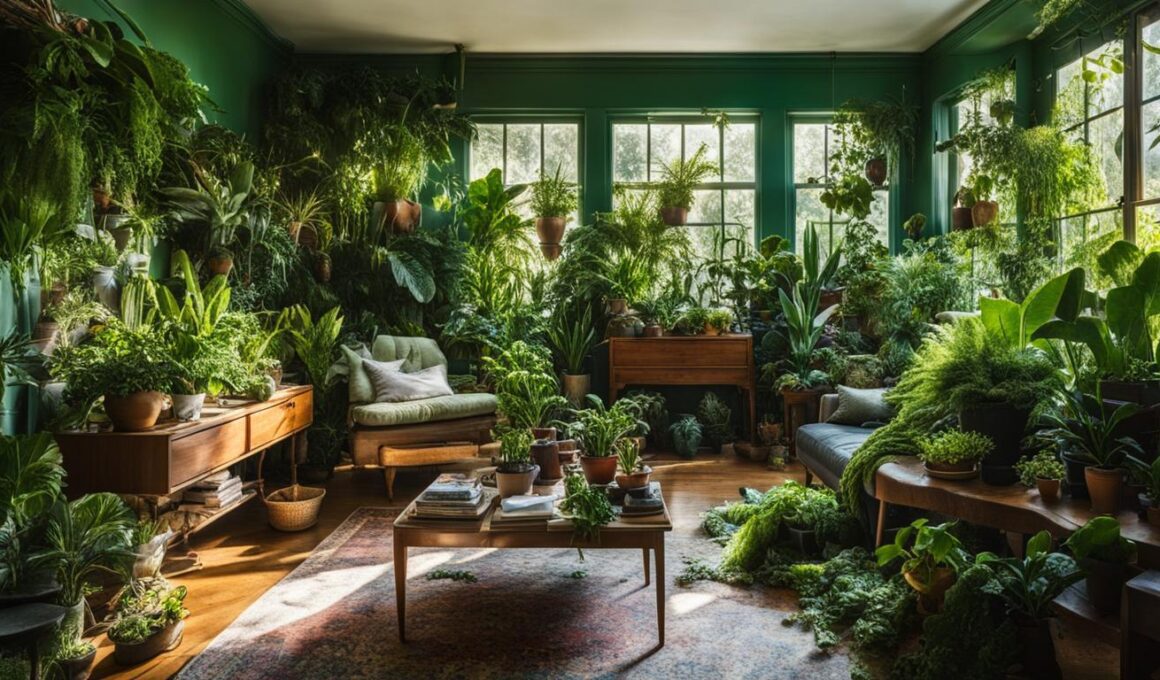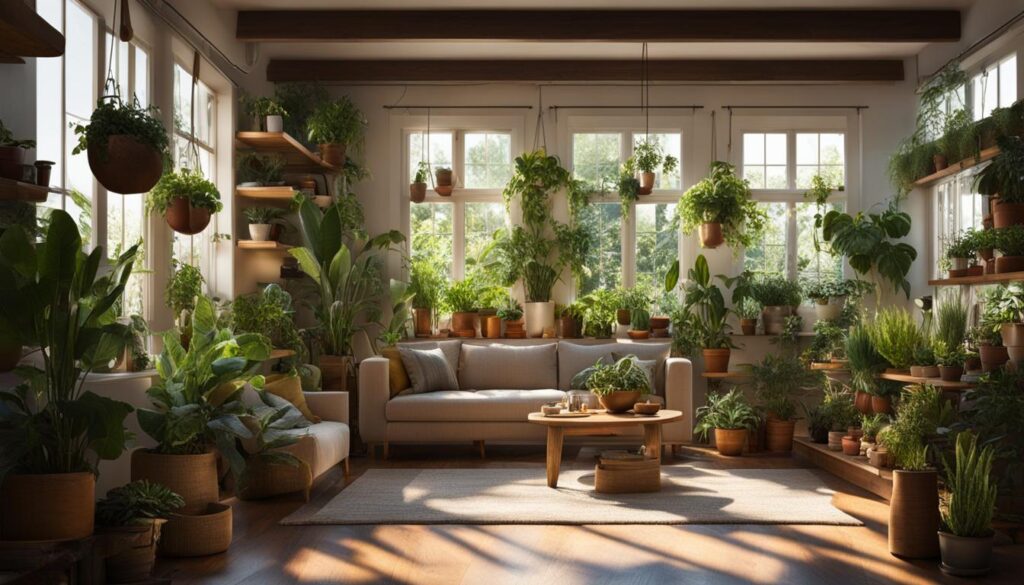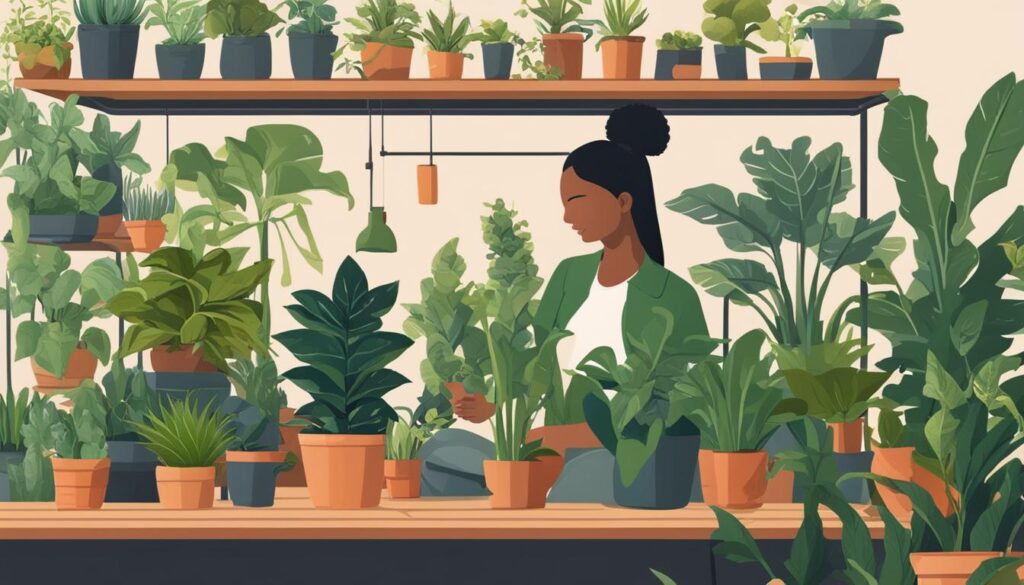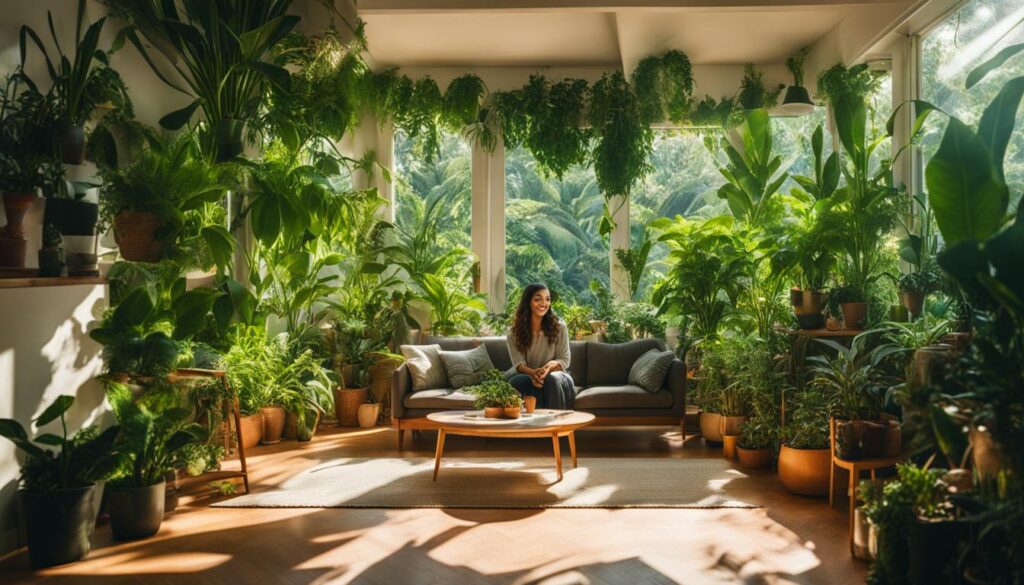Are you an indoor gardening enthusiast with a growing plant collection? You may be wondering how many houseplants are too many. While there is no specific magic number, finding the right balance for you and your home is crucial to maintaining a healthy and thriving indoor garden.
Having too many houseplants can become overwhelming and result in neglect or the inability to provide proper care for each plant. It’s important to consider factors such as space, light, and the time and effort you can dedicate to plant care. By finding the sweet spot between a beautiful plant collection and a manageable one, you can ensure the well-being of both your plants and yourself.
Key Takeaways
- The number of houseplants you should have depends on factors such as space, light, and your ability to care for them.
- Avoid overcrowding your indoor garden to ensure each plant receives proper care.
- Consider factors like watering and pruning time when deciding how many houseplants to have.
- Finding the right balance will help you maintain a healthy and thriving indoor garden.
- Remember to prioritize your well-being and enjoyment of your plant collection.
Benefits of Having Houseplants
Houseplants offer numerous benefits for your physical and mental well-being. They can create a pleasant and calming environment, reduce stress, increase productivity, and even help with faster recovery from illness. Additionally, certain plants are known to improve indoor air quality by filtering out toxins and increasing oxygen levels. Some popular houseplants that have been found to be effective in purifying the air include Snake plant, Aloe Vera, Spider Plant, English Ivy, and Bamboo plant.
| Benefits of Houseplants | Plants for Air Purification |
|---|---|
|
|
“Having houseplants in your indoor space can significantly improve your mental health and overall well-being. The presence of greenery has a soothing effect on the mind, reducing stress and promoting feelings of relaxation. It has been shown to increase focus and productivity, making it beneficial for both work and study environments. Furthermore, certain plants not only beautify your space but also purify the air, removing harmful toxins and increasing oxygen levels. Incorporating these plants into your home can have a positive impact on your health and the quality of the air you breathe.” – Dr. Jane Green, Botanical Health Expert
Having houseplants not only adds beauty and life to your indoor space but also brings various psychological and physiological benefits. Surrounding yourself with indoor plants can create a serene and calming atmosphere, helping to reduce stress and anxiety. The presence of greenery has been shown to have a positive impact on mental health, improving mood and promoting a sense of well-being.
In addition to the mental health benefits, houseplants can also contribute to improved air quality. Research has shown that certain plants have the ability to absorb and filter harmful pollutants, such as volatile organic compounds (VOCs), and release fresh oxygen into the air. This can help create a healthier indoor environment and reduce the risk of respiratory issues.
Indoor Plants and Mental Health
Indoor plants have the ability to positively impact our mental health in several ways. The presence of greenery has a calming effect on our minds, helping to reduce stress and promote relaxation. Being around plants can also improve our mood and increase feelings of happiness and well-being. Whether it’s the act of caring for plants or simply being in their presence, the connection to nature can have a profound impact on our mental state.
Signs You Have Too Many Houseplants
If your indoor space is becoming overcrowded with pots and you are finding it difficult to provide proper care for each plant, it may be a sign that you have too many houseplants. When your plant collection surpasses a manageable size, it can lead to struggling plants, lack of time for watering, pruning, and rotating, or feeling overwhelmed by the demands of plant care.
To help you determine if you have too many houseplants, here are some signs to look out for:
- Overcrowded space: When there are more plants than available space, it can lead to cramped and unhealthy conditions for your plants. Lack of airflow and sunlight can hinder their growth and make it challenging for you to tend to each plant’s needs.
- Struggling plants: If you notice that your plants are not thriving despite your efforts, it could be a sign of overcrowding. Limited access to light, nutrients, and proper ventilation can cause plants to struggle and show signs of stress, such as wilting, yellowing leaves, or stunted growth.
- Plant care challenges: With an extensive collection of plants, it can be challenging to provide adequate care to each one. Watering, pruning, and rotating plants become time-consuming tasks, and you may find yourself neglecting some plants or unable to meet their specific care requirements.
- Limited resources: Having too many houseplants can strain your available resources, including time, space, and finances. The more plants you have, the more time and effort you need to devote to their care. Additionally, purchasing supplies such as potting mix, fertilizers, and plant accessories can become costly.
Recognizing these signs is the first step in addressing the issue of having too many houseplants. It’s important to evaluate your plant collection and consider downsizing to ensure the well-being of both your plants and yourself.
Signs You Have Too Many Houseplants
| Signs | Description |
|---|---|
| Overcrowded space | When there are more plants than available space, it can lead to cramped and unhealthy conditions for your plants. |
| Struggling plants | If your plants are not thriving despite your efforts, it could be a sign of overcrowding. |
| Plant care challenges | With an extensive collection of plants, it can be challenging to provide adequate care to each one. |
| Limited resources | Having too many houseplants can strain your available resources, including time, space, and finances. |
How to Decide Which Plants to Let Go
When it comes to downsizing your houseplant collection, it can be a tough decision to determine which plants to let go. However, considering the needs and requirements of each plant can help you make more informed choices. Here are some factors to consider when deciding which plants to part ways with:
Plant Requirements
Take into account the specific requirements of each plant. Some plants may have special needs, such as high humidity, specific potting mix, or frequent fertilization. If you find it challenging to meet these requirements or if they require additional resources that strain your budget, it may be a good idea to let go of these plants. Focus on plants that are more adaptable and easier to care for, ensuring a healthier and more manageable collection.
Overcrowded Home
If your home is becoming overly crowded with plants, it may be a sign that you have too many. Consider removing duplicate plants or those that have grown excessively large, taking up excessive space. By creating more breathing room and allowing each plant to thrive without competing for resources, you can ensure a more balanced and visually appealing indoor garden.
Consider Downsizing
When deciding which plants to let go, it’s essential to consider downsizing your collection as a whole. Evaluate the overall balance of your indoor garden, considering factors such as color, texture, and growth patterns. Aim for a diverse and well-curated collection that brings you joy while maintaining a manageable size.
Remember, letting go of some plants doesn’t mean you can’t start new ones in the future. By downsizing and making more thoughtful choices, you can create a sustainable and enjoyable houseplant collection that aligns with your resources and preferences.
| Factors to Consider | Which Plants to Let Go |
|---|---|
| Plant Requirements | Plants with special needs that strain your resources. |
| Overcrowded Home | Duplicate or excessively large plants that take up too much space. |
| Consider Downsizing | Create a balanced collection that brings you joy and is manageable. |
Tips for Sustainable Houseplant Care
When it comes to caring for your houseplants, it’s important to adopt sustainable practices that promote responsible plant care. By making conscious choices and incorporating eco-friendly habits into your routine, you can minimize your environmental impact and contribute to a more sustainable plant community.
One simple step you can take is to avoid buying plastic pots whenever possible. Plastic pots contribute to waste and take a long time to decompose. Instead, opt for alternatives such as ceramic or terracotta pots, which are more durable and can be easily reused or recycled.
Another sustainable practice is to choose peat-free potting mixes. Peat is a non-renewable resource that is often used in potting mixes. By using peat-free alternatives, such as coconut coir or compost-based mixes, you can help reduce the demand for peat extraction, which has a negative impact on ecosystems.
“Being a responsible houseplant enthusiast involves practicing sustainability in your plant care routine.”
Additionally, responsible houseplant care involves being mindful of your water usage. Instead of letting water go to waste, collect and reuse excess water from watering your plants. You can also consider implementing a watering schedule based on the specific needs of your plants, which can help prevent overwatering and conserve water.
By following these tips for sustainable houseplant care, you can showcase your commitment to responsible gardening practices and contribute to a greener and more environmentally-friendly home.
The Importance of Resource Management
Caring for houseplants requires effective resource management. To ensure the well-being of your plants and maintain a sustainable indoor garden, it is important to consider various factors such as budget, time management, and knowledge.
Budget
When caring for plants, it is essential to have a clear understanding of your budget for plant care supplies. This includes factors such as potting mix, fertilizers, tools, and any other materials necessary for maintaining healthy plants. By planning and budgeting accordingly, you can ensure that you have the necessary resources to support your indoor garden without any financial strain.
Time Management
Proper plant care requires time and attention. It’s important to evaluate your schedule and determine how much time you can realistically dedicate to caring for your plants. This includes regular watering, pruning, and other maintenance tasks. By effectively managing your time, you can ensure that each plant receives the necessary care and attention it needs to thrive.
Knowledge
Acquiring knowledge about the specific care requirements of each plant is crucial for their success. Take the time to learn about the light, water, and nutrient needs of each plant in your collection. This will help you provide the appropriate conditions and care, preventing unnecessary frustration and plant decline. By educating yourself about plant care, you can become a confident and knowledgeable plant parent.
| Resource Management Considerations | Importance |
|---|---|
| Budget | Ensures you have necessary supplies without financial strain |
| Time Management | Allows for regular care and attention to plants |
| Knowledge | Prevents frustration and decline by providing appropriate care |
By effectively managing your resources – including budget, time, and knowledge – you can create a thriving and sustainable indoor garden. Carefully consider your budget for plant care supplies, manage your time efficiently to provide regular care, and continually educate yourself about the specific needs of your plants. Remember, successful plant care is all about finding the right balance and giving your plants the care they deserve.
Finding the Perfect Plant Match
When selecting new additions to your houseplant collection, take the time to research and understand the care requirements of each plant. Consider factors such as light levels, humidity, and water needs to ensure a successful match. By choosing houseplants that align with your lifestyle and the conditions of your home, you’ll set yourself up for success and foster a sense of joy in their growth and development.
Additionally, don’t be afraid to experiment and try new plants that pique your interest. Exploring different species and varieties can provide a sense of excitement and discovery in your indoor gardening journey. Embrace the learning process and adapt as needed to help your plants thrive and bring you joy for years to come.
“Plants are not just decorations but living beings that can bring immense joy to our lives.” – Plant Lover
Cultivating a Sustainable Plant Community
Building a sustainable plant community involves connecting with other plant enthusiasts and engaging in responsible gardening practices. By sharing plants with friends, family, or local plant communities, you can reduce waste and promote a culture of plant sharing. This not only helps to diversify your collection but also allows others to enjoy the beauty of plants without having to purchase new ones. Additionally, plant sharing fosters a sense of community and can lead to valuable knowledge exchange and friendships.
Responsible gardening practices are also essential for cultivating a sustainable plant community. This includes using environmentally-friendly products and methods, such as organic fertilizers and natural pest control, to reduce the impact on the ecosystem. It’s important to educate yourself about the specific needs and care requirements of each plant to ensure their well-being and prevent unnecessary waste. By taking a proactive and conscious approach to plant care, you contribute to the overall sustainability of your indoor garden and inspire others to do the same.
Furthermore, supporting local nurseries and plant shops that prioritize sustainable practices can have a significant impact on the environment. By choosing to purchase from these establishments, you are encouraging responsible sourcing, reducing transportation emissions, and supporting the local economy. Additionally, many sustainable nurseries offer educational resources and workshops to help you enhance your plant care skills and further promote a sustainable plant community.
Benefits of a Sustainable Plant Community
“A sustainable plant community not only benefits the environment but also provides a platform for knowledge exchange, inspiration, and a sense of belonging.”
A sustainable plant community creates a positive impact on the environment by reducing waste, promoting responsible gardening practices, and supporting local businesses. When like-minded plant enthusiasts come together, they can not only exchange plants but also share valuable tips, tricks, and insights into plant care. This knowledge exchange fosters growth and creativity within the community, empowering individuals to become more effective and responsible gardeners.
Additionally, being part of a sustainable plant community can provide inspiration and motivation. Seeing the success and beauty of other members’ plants can spark new ideas and encourage experimentation within your own collection. It also creates a sense of belonging and camaraderie, as you connect with others who share the same passion for plants and sustainability.
| Ways to Cultivate a Sustainable Plant Community | Benefits |
|---|---|
| Plant sharing through swaps and giveaways | – Reduces waste – Increases plant diversity – Fosters community engagement |
| Supporting local nurseries with sustainable practices | – Reduces environmental impact – Stimulates the local economy – Provides access to educational resources |
| Providing educational resources and workshops | – Empowers individuals to become responsible gardeners – Fosters knowledge exchange – Inspires experimentation and creativity |
By actively participating in a sustainable plant community, you can contribute to a greener and more eco-conscious world while enjoying the many benefits that plants bring to your life. Together, we can create a positive impact on the environment and inspire others to adopt responsible gardening practices.
The Role of Education and Awareness
Plant education is crucial in understanding the environmental impact of our actions and promoting sustainability in houseplant care. By increasing our knowledge about the cultivation and care of indoor plants, we can make informed decisions that minimize negative effects on the environment. Understanding the importance of sustainable practices, such as reducing plastic waste and using alternative materials, empowers us to adopt responsible gardening techniques.
Education also plays a vital role in raising awareness about the environmental implications of houseplant cultivation. By staying informed about the latest research and developments, we can stay updated on sustainable alternatives and resource-efficient practices. Sharing this knowledge with others helps create a more environmentally conscious plant community and encourages individuals to make eco-friendly choices in their own homes.
Benefits of Plant Education and Awareness:
- Encourages responsible plant care practices
- Promotes sustainable alternatives to harmful gardening practices
- Raises awareness about the environmental impact of plastic waste and peat usage
- Empowers individuals to make informed choices when purchasing and caring for houseplants
“Education is the key to promoting sustainability in houseplant care. By understanding the environmental impact of our actions and learning about alternative practices, we can create a more sustainable and eco-friendly plant community.”
Increasing plant education and awareness is an ongoing process. Participating in workshops, online forums, and local plant communities can provide valuable insights and opportunities to further expand our knowledge. By embracing a lifelong learning mindset and sharing our experiences with others, we can collectively work towards a more sustainable future for indoor gardening.
Conclusion
Finding the right balance in your houseplant care is essential for creating a sustainable and thriving indoor garden. By implementing sustainable practices and considering the environmental impact of your choices, you can contribute to a responsible plant community.
Remember to prioritize your well-being along with the well-being of your plants. Choose plants that bring you joy and align with your personal preferences. By finding happiness in your collection, you create a positive and enjoyable indoor environment.
Take steps to minimize the environmental impact of your houseplant care. Reduce plastic waste by avoiding plastic pots whenever possible. Opt for peat-free potting mixes to help conserve this unsustainable resource. Additionally, consider sharing plants with others to promote responsible gardening practices and reduce waste.
With the right balance of houseplant care and sustainable practices, you can enjoy the benefits of indoor gardening while minimizing your environmental footprint. By staying informed, practicing resource management, and finding joy in your collection, you can create a healthier and more eco-friendly indoor garden.
Is Having Too Many Houseplants Similar to Over Fertilizing a Garden?
Having too many houseplants has similar effects to over fertilizing a garden. The symptoms of over fertilization in garden, such as wilting, yellowing leaves, and stunted growth, can also occur with indoor plants. Overfeeding or overwatering can lead to nutrient imbalances and negatively impact the health of both indoor and outdoor plants.
FAQ
How many houseplants should I have?
The number of houseplants you should have depends on various factors, including the amount of space and light you have, as well as the time and effort you can dedicate to their care. Aim for a balance that works for you and your home.
What are the benefits of having houseplants?
Houseplants can create a pleasant and calming environment, reduce stress, increase productivity, and improve indoor air quality by filtering out toxins and increasing oxygen levels.
How do I know if I have too many houseplants?
Signs that you have too many houseplants include struggling plants, lack of time for watering and pruning, feeling overwhelmed by plant care demands, and an overcrowded space.
How do I decide which plants to let go?
When downsizing your houseplant collection, evaluate each plant individually. Consider letting go of plants with special requirements or those that have grown excessively large. Prioritize removing duplicates or plants that are becoming unmanageable in your space.
What are some tips for sustainable houseplant care?
Practice sustainability by making thoughtful plant purchases, avoiding plastic pots, reusing or recycling existing ones, and using peat-free potting mixes. Also consider sharing plants with others to reduce waste and promote a culture of plant sharing.
How can I manage resources for caring for my houseplants?
Manage your plant care resources by considering your budget for supplies, such as potting mix, fertilizers, and tools. Also evaluate your schedule and determine how much time you can dedicate to plant care. Acquiring knowledge about each plant’s care needs will help ensure their success.
How can I find joy in my houseplant collection?
Choose plants that bring you happiness and align with your personal preferences. Find joy in unique ways of displaying your plants and create a positive and enjoyable indoor environment.
How can I cultivate a sustainable plant community?
Contribute to a sustainable plant community by sharing plants with friends, family, or local plant communities to reduce waste and promote responsible gardening practices.
What is the role of education and awareness in sustainable plant care?
Stay informed about current environmental issues related to houseplant cultivation, such as the impact of plastic pots and peat usage. Share knowledge and spread awareness about sustainable houseplant care to create a more environmentally conscious and responsible plant community.
How do I find a balance in my houseplant collection?
Finding the right number of houseplants for your space, time, and resources is essential for creating a healthy and sustainable indoor garden. Implement sustainable practices, find joy in your collection, and prioritize your well-being along with the well-being of your plants.












